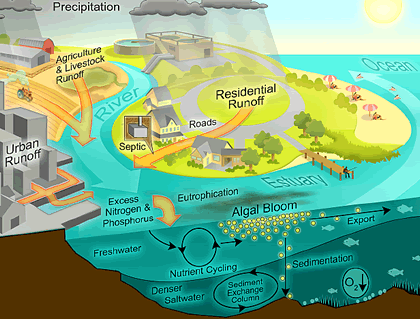 |
| Eutrophication |
Eutrophication is a process in which a body of water changes with time as deposits of nutrients and sediments (particles of sand, silt, and clay) from the surrounding area accumulate.
The process of eutrophication
In euthrophication, the chemical characteristics of the water changes. The biology of the water, in terms of the types of organisms that can live in that water body, also changes. Eutrophication involves an increase in the level of plants’ food sources in the water.
Younger water bodies that have lower levels of nutrients do not support much life. As the nutrients increase, more life can develop in the water. Indeed, the word eutrophic comes from the Greek word eu meaning “well” and trophic, meaning “feeding.”
  |
The term eutrophic, therefore, literally means “well nourished.” At the other end of the scale is an overgrowth of plants including the microscopic chlorophyll containing algae, which will rob the lake of oxygen and cause the deaths of animals and other aquatic life.
Consequences of eutrophication
While eutrophication is a natural process that occurs over thousands of years, it has become associated with what can happen to water when human activities alter the water composition. This form of eutrophication has sometimes been called cultural eutrophication.
The human-made form of eutrophication occurs when food sources for plants and microorganisms find their way into the water. Fertilizer, cleaning detergents, and other human products contains compounds such as phosphorus, nitrogen, and carbon that cause the growth of plants and specifically of algae. Rain washes these compounds off of farm fields, lawns, golf courses, roads, and parks into stream, rivers, ponds, lakes, and ocean waters.
Eutrophication that is artificially accelerated, mainly because of the addition of fertilizer from agricultural run-off and homeowner’s lawns and other chemicals from paved surfaces such as parking lots, can destroy the recreational quality of a lake for people. A formerly beautiful lake can become a smelly dead zone.
 |
| The human-made form of eutrophication |
In the 1970s and 1980s in a benchmark series of studies that has set the standard for the discipline, Canadian scientists studied the effects on the controlled addition of various fertilizers to a series of small lakes.
Because the lakes were isolated, the scientists were able to study what affect each fertilizer had on the health of the lake. These studies demonstrated that, among the various compounds that were added to test sections of lakes, phosphorus was the key chemical that drove the eutrophication process.
One lake was split in half by a plastic divider. Carbon and nitrogen were added to one half of the lake and carbon, nitrogen, and phosphorus were added to the other half. The half that received phosphorus developed huge numbers of a type of microorganism called blue-green algae.
This rapid and huge increase in numbers of algae is called an algal bloom. The resulting algal bloom used much of the available oxygen in the water, causing the death of fish and other creatures that depend on oxygen for survival.
This experiment was key in convincing people around the world that the addition of phosphorus compounds to water was a problem. Later, laws were enacted in Canada that banned the use of most phosphorus compounds in laundry detergent (phosphorus was initially added to laundry detergent to add softness to clothes). As well, these studies have helped drive the creation of environmental regulations elsewhere.
Another source of nitrogen and phosphorus is sewage. In many large cities throughout the world, millions of gallons of raw sewage are still pumped into local waters every day. Whether rain-washed or flushed, nitrogen and phosphorus compounds entering a water body can be used as a source of food by microorganisms in the water, in particular algae.
Effects of eutrophication
The human-made form of eutrophication occurs much faster than natural eutrophication. Instead of a water body changing over thousands of years, a lake undergoing eutrophication as a result of excess runoff (surface water that flows off land) of nitrogen-, phosphorus- and carbon-containing compounds can go from being clean, clear, and home to a variety of life, to a green algae-filled body in only a few years.
Reversing the damage from human-made eutrophication in a body of water can be a difficult process. This is especially true in lakes where the replacement of water, as water flows into the lake at one end and flows out at the other, occurs slowly. During the 1960s Lake Erie underwent eutrophication.
For over a decade, scientists assumed that the lake might never recover. Fortunately, environmental measures such as reducing the use of detergents that contain phosphorus and careful management of agriculture near the lake has helped restore Lake Erie to health.
Harmful effects of eutrophication are also found in the Chesapeake Bay. The bay, located in Maryland, is a large estuary (area where freshwater meets saltwater). In the 1970s the bay was healthy and home to a wide variety of underwater life.
But as massive amounts of nutrients from agricultural and urban activities slowly washed into the bay, the blooms of algae cut off sunlight and reduced the oxygen in the water. As a result, animal life in the bay, such as the famous Maryland crabs, are reducing in numbers.
Citizen groups and government agencies are joining forces to restore the water quality of the Chesapeake bay by reducing the amount of sediments and nutrients that are introduced into the bay, and by protecting the nearby forests and wetlands that serve as natural filters for contaminants. Their joint goal is to restore the Chesapeake water quality to a level that will sustain its natural plant and animal inhabitants by the year 2010.